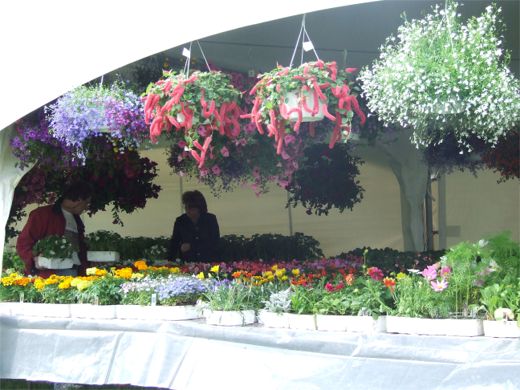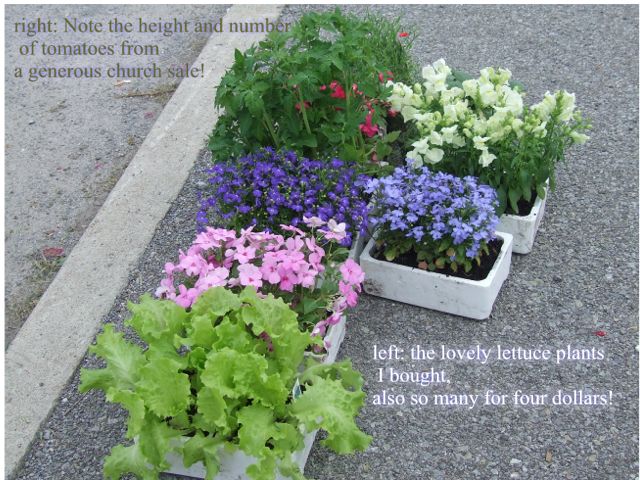CLICK: Color Control Color Choice

I don't know what to write about this month.
It takes all of my strength to tear myself away from the many things
that I could be doing in the garden.
This year, I took the advice of my daughter in law, who has
written a super book on gardening (You
Grow Girl).
She sports a city deck full of edible plants (among many pots of esoterica, like Passion Flower - a medicinal herb) and has written that anyone can grow lettuces, Swiss Chard, or tomatoes in pots.
Knowing that our deck has boiling sun in the summer was a comforting thought, at least in terms of whether or not some of our salad plants would make it in large tubs..
I bought a lovely soft hybrid of the original Paris Cos, which has softer lettuce leaves, and a mild crinkle texture.They have been planted since the 22nd of May, and each is standing up well under the sun, growing perfectly. In fact, my partner and I have already had some of their leaves in our salads, for dinner.
My tub for most of the lettuce is about 15 inches wide, and it is quite deep.I made a well for water conservation in the bottom of the pot, knowing how the sun dries potting soil in an hour, sometimes. My daughter in law recommends a simple trick:
Drill a hole in the cap of a large or smaller pop bottle, fill the bottle with water, invert this, and stick it into your balcony pots, to add a drip system. You can do this next to your garden plants when you go on holiday.
A smaller bottle is probably more aesthetic in a tub planting!
I planted some of the many tomatoes, that I purchased from a church plant sale, in both deck tubs and into the ground.
For the same four dollars a flat, the church sale yielded a dozen more
plants, all four times the size of the tiddlers that the large
department store nurseries are selling. (The chain stores now sell four
puny plants for four dollars).
Worth checking for wholesome church sales!

Last year I had hundreds of leaf hoppers (my Mother always called them "spittle bugs", since they make a white spit of foam around themselves, as a nest). These are a soft, innocent looking green colour, and mature to brownish-faun later on.
I never paid attention to the little things before, but last year, I noticed that they crinkled and rusted the tops of all my about-to-flower plants. I had to cut away all of the bad stuff (about one quarter of my flowers) and spray the foliage with a drop of dish washing detergent in water. At least, that did the trick, but I totally lost two of the herbs that I was watching for cross-hybridization.
Being an organic gardener, I am not sure of how agribusiness medicinal herbs are handled. If they are grown in a greenhouse, how can a cross-hybridization of natures' plan provide the random miracle of a potential advance in medicine? I believed that I was watching one, you see.
Still, though I have lost the plants that I was watching, perhaps their progeny will have strengthened the hybrid. Time will tell.
I am a rank amateur at herbalism or horticulture, but I use my tuned sensibilities when understanding plants homeopathically. Once a person has been given some homeopathic treatment, their senses are better alerted to the needs of the body, and also to the capability of the bodys' amino acids in providing nucleopeptides, which can mimick or recreate medicine that the body needs, often without excessive intake of an actual pharmaceutical.
As an amateur, I have given some of my remedies to a local pharmacist, where obvious expertise can make a silk purse out of a sows' ear. I feel that (not having the equipment or education to explore or market a medicinal herbal idea) it is not wrong to suggest a medicines' powers to a pharmacist or to a Naturopath, who can give this scientific scrutiny. Why not, if it turns you on?
My pharmacist said that I had to test with free samples to 100 people, before furthering my perfume business idea.
I discovered that I had to buy 1,000 of these bottles for a starter. So I gave up, being a broke, ordinary household inventor!
My Mom loved the perfume, though!
Bye for now,
Sue
